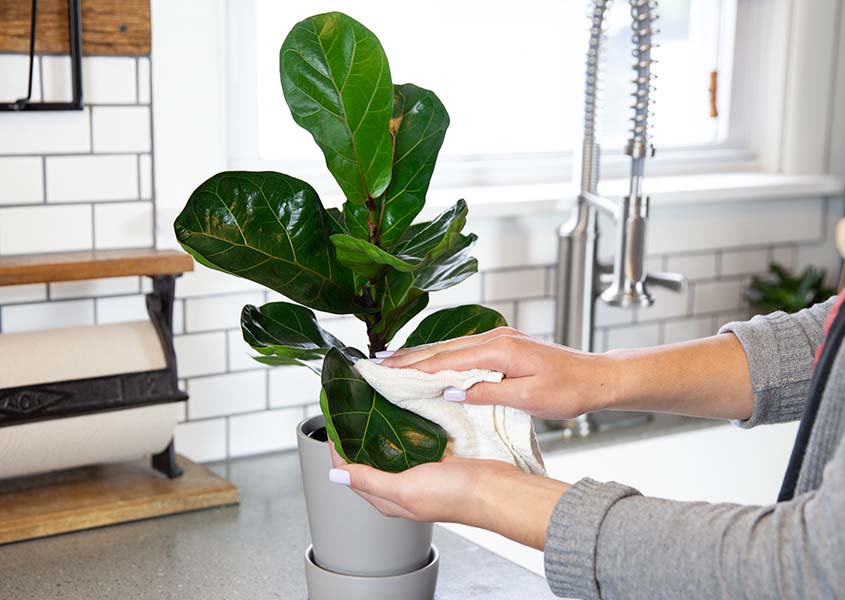How to Care for a Fiddle Leaf Fig
The Fiddle Leaf Fig has a bit of a reputation as a finicky plant, but as long as you stay consistent in your care for the Fiddle Leaf, it should live a happy and healthy life at home with you. Read on for detailed tips on caring for your Fiddle Leaf Fig.
How much light does a Fiddle Leaf Fig need?
Before you bring a Fiddle Leaf Fig home, make sure you have a sunny area for it to thrive. Fiddle Leaf Figs like bright, indirect light and should be kept in a room that has plenty of sunshine, but not directly in the sun or they will overheat.
To help your Fiddle Leaf absorb light better, make sure to dust off the leaves regularly using a gentle touch and a soft cloth. Microfiber is a great choice, or use a washcloth dampened with plain water. No special cleaners needed!
How much water does a Fiddle Leaf Fig need?
Fiddle Leaf Figs like to be watered on a pretty precise schedule, but their needs fluctuate based on ambient humidity and temperature in your home. Water your Fiddle Leaf when the top inch of its soil is dry. Simply poke your finger into the soil and check for moisture. Once you figure out your Fiddle Leaf Fig’s preferred watering schedule, you should only need to adjust it seasonally in case of temperature or humidity changes. Typically you should expect to water your Fiddle Leaf Fig about once a week.
Does a Fiddle Leaf Fig need fertilizer?
We grow our Fiddle Leaf Figs to be hardy and strong, so fertilization within your first six to twelve months of ownership isn’t strictly necessary. We grow our plants to make a comfortable and healthy transition from greenhouse to home environment.
As your Fiddle Leaf Fig grows and begins creating new leaves over time, however, it may appreciate regular fertilizer. Recommendations differ for each fertilizer, so note your particular instructions. In general, you can fertilize regularly in the spring and summer (weekly to monthly, depending on your fertilizer’s recommendations), half as often in the fall, and not at all during winter when the Fiddle Leaf Fig is in a dormant stage. There are special Fiddle Leaf Fig fertilizer products available on the market that can help promote growth if your Fig needs a little help.
What is the best temperature for a Fiddle Leaf Fig?
The Fiddle Leaf Fig enjoys a warm, humid environment. Since that’s probably not your cup of tea, room temperature is generally fine - but your Fiddle Leaf needs to stay away from cold drafts. You can also run a humidifier to keep the air moist, particularly in the winter to combat dry air.
Common Fiddle Leaf Fig problems
Some of the most common issues that befall a Fiddle Leaf Fig result in brown spots and leaf drop, which can be caused by a variety of issues. The health of your fiddle-shaped leaves has a lot to say about the health of your plant, but it’s possible to save the plant even if it loses some leaves.
Root Rot and Overwatering
One of the most common causes of brown spots and leaf drop is root rot, due to overwatering and too much moisture pooling at the roots of the plant, leading to fungal infection. Spots may start small, grow larger, and then the whole leaf will drop off the plant. If root rot is the culprit, you’ll probably see spots and leaf drop on older leaves first.
To avoid root rot, keep your Fiddle Leaf Fig in a tight pot, since too much soil and space can lead to more moisture collecting around your plant’s roots. Our five inch pot with a drainage hole is well suited to keep your Fiddle Leaf’s roots happy - just let it dry between waterings!
To treat root rot, allow your plant to dry out completely before rewatering, and make sure it has plenty of indirect sunlight. You can trim brown edges and spots off the leaves with clean shears.
Underwatering
Of course, not enough water can be a problem just like too much water. If your Fiddle Leaf Fig isn’t getting enough water, the leaves will begin to form large brown spots and start to die and curl from the edges inward. Dry Fiddle Leaf Figs will also have dry, hard soil that recedes and shrinks away from the edge of the pot.
To combat dryness, try running a humidifier nearby to increase the humidity. This is especially helpful in winter when the air is more dry in the average home. Stick to a regular watering schedule and monitor the soil to make sure it allows the water to pass through the roots and not just around the edges of the pot. If the soil is too packed and dry, you may need to repot your Fiddle Leaf Fig.
Drafts and Cold
Keeping your Fiddle Leaf Fig somewhere drafty or accidentally leaving it exposed to cold air will lead to a leafy tantrum and it may drop leaves. Cold temperatures are obviously more likely in the winter, when the Fiddle Leaf Fig is naturally dormant - don’t be discouraged if you don’t think you’ve saved your Fig soon enough. With proper care you should see new growth in the spring.
To save a Fiddle Leaf Fig after exposure to cold, you need to be patient. The Fiddle Leaf will mostly repair itself and grow after a period of time. Don’t prune any parts of the stalk or any branches unless they look mushy or moldy. Check the stalk to make sure it’s still supportive and strong to ensure your Fiddle Leaf Fig is still healthy enough to recover - if it’s shriveled and looks dead, it’s probably too late. Keep it watered regularly to avoid soil shrinkage and drying out as mentioned above. And most importantly, keep it warm in the future!
Happy Fiddling!
We hope these care tips help you feel empowered to care for this beautiful plant with a picky reputation. Reach out to us if you have questions about caring for your own Fiddle Leaf Fig at home. We’re here to help!

